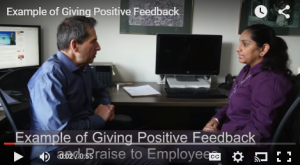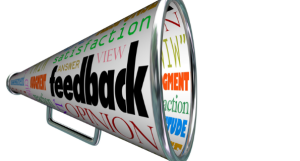 Positive feedback is one of the most powerful tools leaders and team members can use to motivate and engage employees and build strong team spirit. It does not cost anything to use other than effort and attentiveness to people’s performance.
Positive feedback is one of the most powerful tools leaders and team members can use to motivate and engage employees and build strong team spirit. It does not cost anything to use other than effort and attentiveness to people’s performance.
In my previous articles and videos I covered the importance of feedback and how to give negative feedback. Feedback needs to be balanced between positive and negative to both motivate and guide employees and team members. If you regularly give positive feedback, people are more open to your negative feedback.
Make it Personal
 Contrary to negative feedback, positive feedback needs to be personal. Rather than saying good job on that report, point out the attributes the person has applied to produce the result. That might sound like; that customer survey satisfaction report was well done and it shows your ability to focus in on critical data and discern what information is important to have for strategic decision-making. Great job!
Contrary to negative feedback, positive feedback needs to be personal. Rather than saying good job on that report, point out the attributes the person has applied to produce the result. That might sound like; that customer survey satisfaction report was well done and it shows your ability to focus in on critical data and discern what information is important to have for strategic decision-making. Great job!
Of course this takes more forethought than just saying good job on that report. But the benefits for the recipient is great. Giving feedback properly will reinforce the strengths of the person and how they are using their skills to contribute to the team and organization. This builds self-esteem and confidence and motivates the person to use these strengths even more because they know they are on the right track.
Make it Timely
 The best time to give positive feedback is right away. If someone hits a homerun in baseball you congratulate them immediately. The same is true at work. When you see something worthy of praise or positive feedback let the person know then. The impact is much greater.
The best time to give positive feedback is right away. If someone hits a homerun in baseball you congratulate them immediately. The same is true at work. When you see something worthy of praise or positive feedback let the person know then. The impact is much greater.
Make it Public
Positive feedback can be given within the ear shot of fellow employees. This further raises the person’s self-esteem. In contrast, negative feedback should always be given in private.
Make it a Habit
 The biggest challenge to using positive feedback as a motivational tool is habit. If you are not giving positive feedback regularly you must develop the habit and this means doing it regularly until it becomes second nature. This requires conscious effort and at first may seem uncomfortable. Your initial attempts might feel forced but don’t let this stop you. Be genuine and the person will feel your sincerity and appreciate your effort.
The biggest challenge to using positive feedback as a motivational tool is habit. If you are not giving positive feedback regularly you must develop the habit and this means doing it regularly until it becomes second nature. This requires conscious effort and at first may seem uncomfortable. Your initial attempts might feel forced but don’t let this stop you. Be genuine and the person will feel your sincerity and appreciate your effort.
Example
Here is an example video of giving positive feedback that I recorded with my assistant Sonia. Click on the image to watch.

Stephen Goldberg













